Contents
An incomplete list of the earliest films produced in Japan ordered by year between the 1898 and 1909. For an A-Z of films see Category:Japanese films.
An incomplete list of the earliest films produced in Japan ordered by year between the 1898 and 1909. For an A-Z of films see Category:Japanese films.
| Title | Director | Cast | Genre | Notes | ||
|---|---|---|---|---|---|---|
| 1898 | ||||||
| Nuno sarashi | Short Documentary | |||||
| 1899 | ||||||
| Momijigari | Shibata Tsunekichi | Onoe Kikugoro V, Ichikawa Danjūrō IX | Kabuki | Designated an Important Cultural Property in 2009. [1] | ||
| Osaka Dōtonbori no Zu | ||||||
| Osaka Maiko no Odori | ||||||
| Kappore | ||||||
| Ginza Machi Jikkei | ||||||
| Genroku Hanami Odori | ||||||
| Koyo no Hashi | Atari Musashiya Rokusuke Fukunakamuraya | Cinematography by Shiro Asano | ||||
| Shin Kanoko | Botan Hinoya Kaneko Numataya | Cinematography by Shiro Asano | ||||
| Asakusa Nakamise | Cinematography by Shiro Asano | |||||
| 1908 | ||||||
| Taikoki judanme | Sakiji Ichikawa, Kasen Nakamura, Utae Nakamura | Studio: M. Pathe. 17-minute print extant. [2] | ||||
| 1909 | ||||||
| Goban tadanobu | Shozo Makino | Matsunosuke Onoe, Ichitaro Kataoka, Kitsuraku Arashi | ||||
Anime is hand-drawn and computer animation originating from Japan. In Japan and in Japanese, anime describes all animated works, regardless of style or origin. However, outside of Japan and in English, anime is colloquial for Japanese animation and refers specifically to animation produced in Japan. Animation produced outside of Japan with similar style to Japanese animation is referred to as anime-influenced animation.
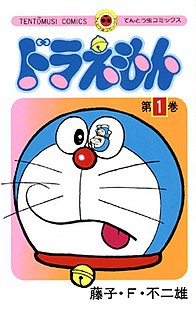
Doraemon is a Japanese manga series written and illustrated by Fujiko F. Fujio. The manga was first serialized in December 1969, with its 1,345 individual chapters compiled into 45 tankōbon volumes and published by Shogakukan from 1970 to 1996. The story revolves around an earless robotic cat named Doraemon, who travels back in time from the 22nd century to aid a boy named Nobita Nobi.

The cinema of China is one of three distinct historical threads of Chinese-language cinema together with the cinema of Hong Kong and the cinema of Taiwan.

Hayao Miyazaki is a Japanese animator, director, producer, screenwriter, author, and manga artist. A co-founder of Studio Ghibli, he has attained international acclaim as a masterful storyteller and creator of Japanese animated feature films, and is widely regarded as one of the most accomplished filmmakers in the history of animation.

Kyoto, officially Kyoto City, is the capital city of Kyoto Prefecture in Japan. Located in the Kansai region on the island of Honshu, Kyoto forms a part of the Keihanshin metropolitan area along with Osaka and Kobe.
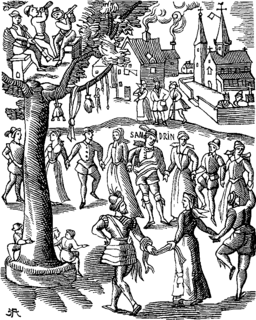
A festival is an event ordinarily celebrated by a community and centering on some characteristic aspect of that community and its religion or cultures. It is often marked as a local or national holiday, mela, or eid. A festival constitutes typical cases of glocalization, as well as the high culture-low culture interrelationship. Next to religion and folklore, a significant origin is agricultural. Food is such a vital resource that many festivals are associated with harvest time. Religious commemoration and thanksgiving for good harvests are blended in events that take place in autumn, such as Halloween in the northern hemisphere and Easter in the southern.
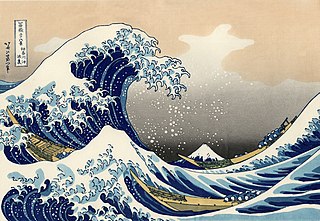
The culture of Japan has changed greatly over the millennia, from the country's prehistoric Jōmon period, to its contemporary modern culture, which absorbs influences from Asia and other regions of the world.
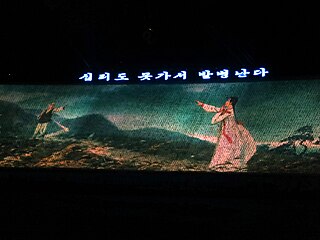
"Arirang" is a Korean folk song. There are about 3,600 variations of 60 different versions of the song, all of which include a refrain similar to, "Arirang, arirang, arariyo " It is estimated the song is more than 600 years old.

Little Tokyo also known as Little Tokyo Historic District, is an ethnically Japanese American district in downtown Los Angeles and the heart of the largest Japanese-American population in North America. It is the largest and most populous of only three official Japantowns in the United States, all of which are in California. Founded around the beginning of the 20th century, the area, sometimes called Lil' Tokyo, J-Town, 小東京 (Shō-tōkyō), is the cultural center for Japanese Americans in Southern California. It was declared a National Historic Landmark District in 1995.
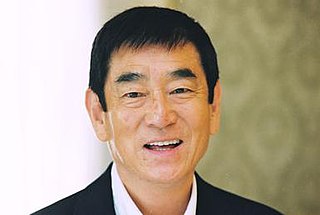
Ken Takakura, born Goichi Oda, was a Japanese actor and singer who appeared in over 200 films. Affectionately referred to as "Ken-san" by audiences, he was best known for his brooding style and the stoic presence he brought to his roles. He won the Japan Academy Prize for Outstanding Performance by an Actor in a Leading Role four times, more than any other actor. Takakura additionally received the Japanese Medal of Honor with purple ribbon in 1998, the Person of Cultural Merit award in 2006, and the Order of Culture in 2013.
Kyoto Animation Co., Ltd., often abbreviated KyoAni, is a Japanese animation studio and light novel publisher located in Uji, Kyoto Prefecture. Founded in 1981 by Yoko and Hideaki Hatta, it has produced anime works including The Melancholy of Haruhi Suzumiya (2006), Clannad (2007), K-On! (2009), Free! (2013), Sound! Euphonium (2015), A Silent Voice (2016), and Violet Evergarden (2018).
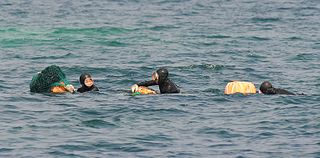
Haenyeo are female divers in the Korean province of Jeju, whose livelihood consists of harvesting a variety of mollusks, seaweed, and other sea life from the ocean. Known for their independent spirit, iron will and determination, haenyeo are representative of the semi-matriarchal family structure of Jeju.

The Ministry of Culture is the ministry of the Republic of China (Taiwan) that promotes cultural and creative industries. The ministry also maintains the National Repository of Cultural Heritage.

The Agency for Cultural Affairs is a special body of the Japanese Ministry of Education, Culture, Sports, Science and Technology (MEXT). It was set up in 1968 to promote Japanese arts and culture.
Japanese popular culture includes Japanese cinema, cuisine, television programs, anime, manga, video games, music, and doujinshi, all of which retain older artistic and literary traditions; many of their themes and styles of presentation can be traced to traditional art forms. Contemporary forms of popular culture, much like the traditional forms, are not only forms of entertainment but also aspects to distinguish contemporary Japan from the rest of the modern world. There is a large industry of music, films, and the products of a huge comic book industry, among other forms of entertainment. Game centers, bowling alleys, and karaoke parlors are well-known hangout places for teens while older people may play shogi or go in specialized parlors. Since the end of the US occupation of Japan in 1952, Japanese popular culture has been deeply influenced by American media. However, rather than being dominated by American products, Japan localised these influences by appropriating and absorbing foreign influences into local media industries. Today, Japanese popular culture stands as one of the leading and most prominent popular cultures around the world.
The Japan Media Arts Festival is an annual festival held since 1997 by Japan's Agency for Cultural Affairs. The festival begins with an open competition and culminates with the awarding of several prizes and an exhibition.
Akira Sasō is a Japanese illustrator and educator. He has won a Tezuka Osamu Cultural Prize and two Japan Media Arts Awards, the latter for his manga Shindō (1997–98) and Maestro (2003–07).

Momijigari is a Japanese film shot in 1899 by Shibata Tsunekichi. It is a record of the kabuki actors Onoe Kikugoro V and Ichikawa Danjūrō IX performing a scene from the kabuki play Momijigari. It is the oldest extant Japanese film and the first film to be designated an Important Cultural Property.